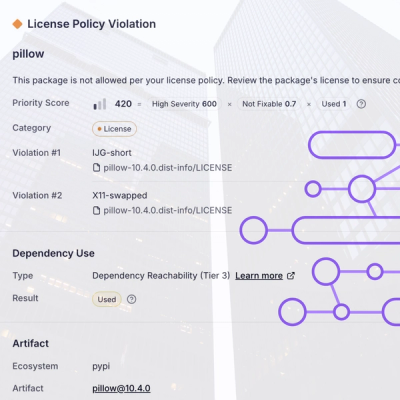
Research
/Security News
Critical Vulnerability in NestJS Devtools: Localhost RCE via Sandbox Escape
A flawed sandbox in @nestjs/devtools-integration lets attackers run code on your machine via CSRF, leading to full Remote Code Execution (RCE).
Component for Dash based on react-awesome-query-builder. The component is a way to graphically generate WHERE clauses for SQL queries.
pip install dash_query_builder
To use Dash Query Builder (DQB), you need to have a Dash app and a dictionary of fields. The fields property is a dictionary of fields and their properties, following the config.fields docs. The only caveat is that JavaScript cannot be used as in the example.
For instance the following dictionary is valid:
fields = {
"qty": {
"label": "Qty",
"type": "number",
"fieldSettings": {"min": 0},
"valueSources": ["value"],
"preferWidgets": ["number"],
},
"price": {
"label": "Price",
"type": "number",
"valueSources": ["value"],
"fieldSettings": {"min": 10, "max": 100},
"preferWidgets": ["slider", "rangeslider"],
"operators": ["equal", "between"],
},
"color": {
"label": "Color",
"type": "select",
"valueSources": ["value"],
"fieldSettings": {
"listValues": [
{"value": "yellow", "title": "Yellow"},
{"value": "green", "title": "Green"},
{"value": "orange", "title": "Orange"},
]
},
},
"is_promotion": {
"label": "Promo?",
"type": "boolean",
"operators": ["equal", "is_empty"],
"valueSources": ["value"],
},
}
The basic component can be created via:
from dash import Dash, html
import dash_query_builder as dqb
fields =...
app=Dash(__name__)
app.layout=html.Div([dqb.DashQueryBuilder(fields=fields)])
app.run_server()
This will run the app similar to this:
There are other properties available as well, with defaults in parentheses.
With the above parameters, a query builder will be created with an empty tree. To pre-populate the query builder, there are several ways to do so:
loadFormat=="tree": Set tree to a valid tree object.loadFormat=="spelFormat": Set spelFormat to a valid SpEL string.loadFormat=="jsonLogicFormat": Set jsonLogicFormat to a valid jsonLogic object.Once loadFormat is set, the tree/query builder will update when the query is changed or when the corresponding property is changed.
The loadFormat can be changed via a callback, while keeping the same tree.
Here's an example using usage.py:
DQB has a built-in parser for SQL queries. The parser is relatively simple as far as parsers go, but it does what I need it to.
It will parse the query and return a template string and a parameter dictionary. The template string will be in pyformat style, as
specified in PEP 249.
from dash_query_builder.where_parser import WhereParser
where_parser = WhereParser()
template, params = where_parser.get_template("qty > 15 and price between 10 and 20")
print(template) # (qty > %(YSaAddDFs27s)s AND price BETWEEN %(W5PRwTGpFqqF)s AND %(N2nGExcGaUSt)s)
print(params) # {'YSaAddDFs27s': 15, 'W5PRwTGpFqqF': 10, 'N2nGExcGaUSt': 20}
Currently, only pyformat is supported. PRs are welcome!
just sync
just compile
just build
just publish
just -lFAQs
Component for Dash based on react-awesome-query-builder
We found that dash-query-builder demonstrated a healthy version release cadence and project activity because the last version was released less than a year ago. It has 1 open source maintainer collaborating on the project.
Did you know?

Socket for GitHub automatically highlights issues in each pull request and monitors the health of all your open source dependencies. Discover the contents of your packages and block harmful activity before you install or update your dependencies.

Research
/Security News
A flawed sandbox in @nestjs/devtools-integration lets attackers run code on your machine via CSRF, leading to full Remote Code Execution (RCE).

Product
Customize license detection with Socket’s new license overlays: gain control, reduce noise, and handle edge cases with precision.

Product
Socket now supports Rust and Cargo, offering package search for all users and experimental SBOM generation for enterprise projects.